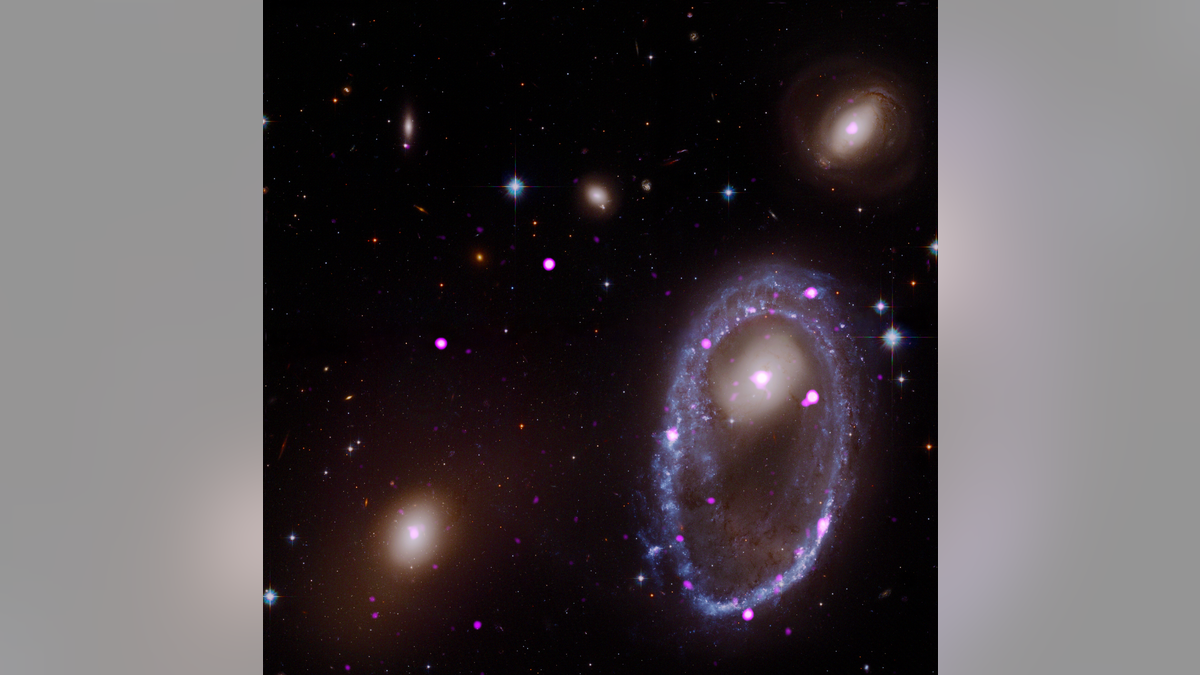
A composite image of the ring galaxy AM 0644-741. The image includes X-ray data from the Chandra X-ray Observatory (purple) and optical data from NASA's Hubble Space Telescope (red, green and blue). The galaxy AM 0644 is located in the lower right. (NASA/CXC/INAF/A. Wolter et al; NASA/STScI)
A giant ring of black holes has been discovered 300 million light-years away, offering new clues about what happens when galaxies collide.
Using NASA's Chandra X-ray Observatory, astronomers detected a very bright source of X-rays that is likely fueled by either a ring of stellar-mass black holes or neutron stars — the small, dense corpses left after stellar explosions, — according to a new study.
The bright X-ray source emanates from the ring galaxy AM 0644-741 (abbreviated AM 0644), which lies approximately 300 million light-years from Earth. By combining data from Chandra and NASA's Hubble Space Telescope, astronomers created a composite image of X-ray and optical observations of the galaxy. [Images: Black Holes of the Universe]
The observed ring of black holes or neutron stars is believed to be the result of a galaxy collision. The galaxies were likely drawn together by gravity, and the gravitational force from one galaxy created waves in the gas surrounding its neighbor, which, in this case, is AM 0644. The ripples would have then caused the gas to expand or clump together in denser areas, triggering the birth of new stars.
More From Space.com
"The most massive of these fledgling stars will lead short lives — in cosmic terms — of millions of years," representatives from the Chandra X-ray Observatory said in a statement. "After that, their nuclear fuel is spent, and the stars explode as supernovas, leaving behind either black holes with masses typically between about five to twenty times that of the sun, or neutron stars with a mass approximately equal to that of the sun."
The black holes or neutron stars have close cosmic companions from which they siphon gas. This gas falls inward and is heated by friction, creating the bright X-rays detected by Chandra, according to the statement.
What's more, the bright X-rays from AM 0644 are classified as ultraluminous X-ray sources (ULXs). These objects produce hundreds to thousands of times more X-rays than most other neutron star or black-hole X-ray binaries. However, the identity of the individual ULXs in AM 0644 is currently unknown, according to the statement.
In addition to the ring of black holes or neutron stars surrounding AM 0644, the Chandra data revealed a supermassive black hole located at the center of the galaxy, as well as a rapidly growing black hole that's located well behind the galaxy at a distance of 9.1 billion light-years from Earth.
And AM 0644 wasn't the only ring galaxy Chandra inspected. The telescope observed six other ring galaxies, revealing a total of 63 X-ray sources, 50 of which are considered ULXs.
In fact, the seven ring galaxies contain a higher number of ULXs per galaxy than other types of galaxies. Therefore, these galaxies could help astronomers better understand the origin of ULXs, according to the statement.
The study was published Aug. 10 in The Astrophysical Journal and is available online.
Original article on Space.com.
